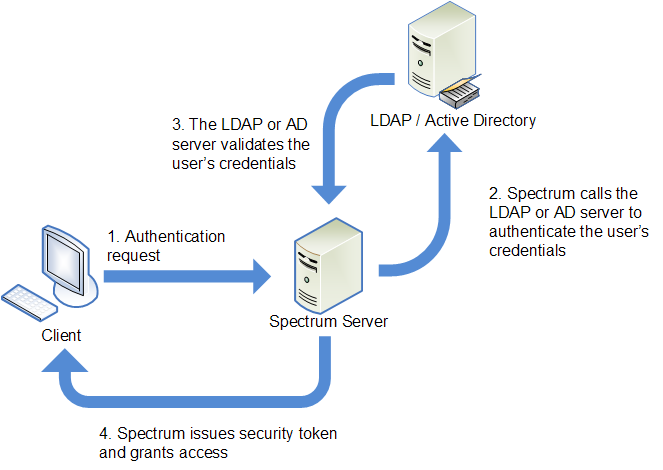Spectrum™ Technology Platform can be configured to use an LDAP or Active Directory
server for authentication. When a user logs in to Spectrum™ Technology Platform,
the user's credentials are verified using LDAP or AD. The system then checks to see
if there is a Spectrum™ Technology Platform user with the same name. If there is,
the user is logged in. If there is not, then a Spectrum™ Technology Platform user
account is automatically created for the user and given the role
user.
The following diagram illustrates this process:

Before configuring Spectrum™ Technology Platform to use a directory service for
authentication, confirm that your directory service meets these requirements:
- For LDAP, the directory server must be LDAP Version 3 compliant.
- There are no specific requirements for the Active Directory server.
- Spectrum™ Technology Platform does not support SSL communication with the LDAP
or Active directory server.
Note: We recommend that you contact Pitney Bowes Technical Support or
Professional Services to guide you through this process.
-
If there are existing users configured in Management Console and you want to
use them after you enable LDAP or Active Directory authentication, create those
users in your LDAP or Active Directory system. Be sure to use the same user name
as in Spectrum™ Technology Platform.
Note: You do not need to create the "admin" user in LDAP or Active Directory
since this user will continue to use Spectrum™ Technology Platform for
authentication after you enable LDAP or Active Directory
authentication.
-
Stop the Spectrum™ Technology Platform server.
-
Turn on LDAP or Active Directory authentication:
-
Open this configuration file in a text editor:
server\app\conf\spectrum-container.properties
-
Set the property
spectrum.security.authentication.basic.authenticator
to LDAP:
spectrum.security.authentication.basic.authenticator=LDAP
The setting LDAP is used to enable Active
Directory as well as LDAP.
-
Save and close the file.
-
Configure the connection properties:
-
Open this configuration file in a text editor:
server\app\conf\spring\security\spectrum-config-ldap.properties
-
Modify these properties.
- spectrum.ldap.url
- The URL, including port, of the LDAP or Active Directory
server. For
example,
spectrum.ldap.url=ldap://ldapserver.example.com:389/
- spectrum.ldap.dn.format
- The format to use to search for the user account in LDAP or
Active Directory. Use the variable %s
for the user name. For
example,
LDAP:
spectrum.ldap.dn.format=uid=%s,ou=users,dc=example,dc=com
Active
Directory:
spectrum.ldap.dn.format=%s@example.com
- spectrum.ldap.dn.base
- The distinguished name (dn) to search for user accounts in
LDAP or Active Directory. For
example,
LDAP:
spectrum.ldap.dn.base=ou=users,dc=example,dc=com
Active
Directory:
spectrum.ldap.dn.base=cn=Users,dc=example,dc=com
- spectrum.ldap.search.filter
- A search filter to use when searching for attributes such as
roles. The search filter can contain these variables:
{user} is the user name logging into
Spectrum™ Technology Platform{dn} is the distinguished name
specified in
spectrum.ldap.dn.base.
For
example:LDAP:
spectrum.ldap.search.filter=uid={user}
Active
Directory:
spectrum.ldap.search.filter=userPrincipalName={dn}
- spectrum.ldap.attribute.roles
- Optional. Specifies the LDAP or Active Directory attribute
that contains the name of the Spectrum™ Technology Platform roles for the user. The role name you specify in the LDAP
or Active Directory attribute must match the name of the
role defined in Spectrum™ Technology Platform.
For
example, to apply the roles defined in the attribute
spectrumroles you would
specify:
spectrum.ldap.attribute.roles=spectrumroles
If
this attribute contains a role named
designer then the
designer role would be granted to the
user.
You can only specify one attribute but the
attribute may contain multiple roles. To specify multiple
roles inside an attribute, separate each with a comma. You
can also specify a multi-value attribute, with each instance
of the attribute containing a different role. Only the roles
specified in this one attribute are used in Spectrum™ Technology Platform. No other LDAP or Active Directory
attributes will have any impact on Spectrum™ Technology Platform roles.
If the user has roles
assigned to it in Spectrum™ Technology Platform, the
user's permissions are the union of the roles from LDAP or
Active Directory and the roles from Spectrum™ Technology Platform.
Note: When a user logs in for the
first time, if the user does not have a Spectrum™ Technology Platform user account one is created
automatically and given the role user.
The effective permissions for the user are the union of the
permissions in the user role and the
roles specified in the attributes listed in the
spectrum.ldap.attribute.roles
property.
Note: When you view the user's roles in
Management Console you will not see the roles assigned to
the user by the
spectrum.ldap.attribute.roles
property.
- spectrum.ldap.pool.min
- The minimum size of the connection pool for connections to
the LDAP or Active Directory server.
- spectrum.ldap.pool.max
- The maximum number of simultaneous connections to the LDAP
or Active Directory server.
- spectrum.ldap.timeout.connect
- Specifies how long to wait to establish a connection to the
LDAP or Active Directory server, in milliseconds. The
default is 1000 milliseconds.
- spectrum.ldap.timeout.response
- Specifies how long to wait for a response from the LDAP or
Active Directory server after the connection is established,
in milliseconds. The default is 5000 milliseconds.
-
Save and close the properties file.
-
Start the Spectrum™ Technology Platform server.
If you are running Spectrum™ Technology Platform in a cluster, you must modify the
spectrum-container.properties file and the
spectrum-config-ldap.properties file on each of the servers in
the cluster. Stop the server before modifying the file, then start the server after
you are done modifying the file. If you mapped an LDAP attribute value to a role,
this mapping will replicate to all nodes in the cluster, so you do not need to
repeat the mapping procedure in the JMX console.
